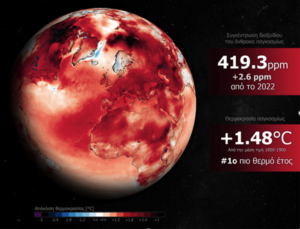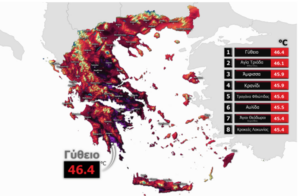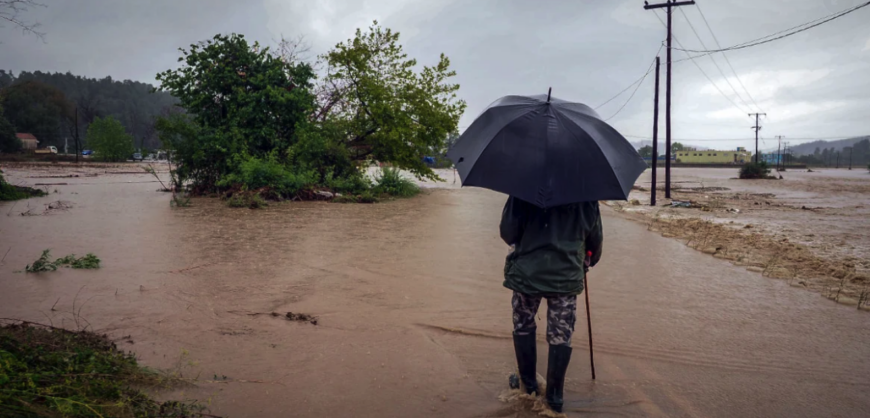The future is ominous for Greece and in general in terms of the climate conditions that the planet is expected to experience as the years to come are expected to be warmer due to the climate crisis. 2023 was the hottest year worldwide with the temperature exceeding by 1.48 degrees Celsius the average value of the pre-industrial period (1850-1900).
Also very significant was the increase in global carbon dioxide levels, with the average value in 2023 reaching 419.3 ppm, 2.6 ppm more than the average value in 2022.
The above was highlighted during the 2023 climate assessment which is an initiative of the Climatebook.gr information hub.
In the presentation the scientists developed data for Greece which is expected in the coming years to have strong extreme phenomena such as floods, heat waves and fires due to the climate crisis.
In particular, Dr Konstantinos Lagovardos said that 2023 was the hottest year in the last 30 years.

The average maximum temperature in Greece in 2023 was in all regions higher than the average value of the climate period 1991-2020.
December 2023 was the warmest since 1991, while May 2023 was the 4th coldest since 1991.”
In fact, according to scientists, during July 2023, the country experienced the longest heatwave ever recorded.
The duration of the phenomenon concerned the period from 12 to 26 July. On July 23, more than 150 areas of the country had maximum temperatures exceeding 40 degrees.

The highest temperature recorded on this day was in Gythio, with a maximum of 46.4 degrees.
But also at sea the temperature was in all seas higher than the climate value for the period 1991-2020.
Especially in areas of the south-eastern Aegean, the positive deviation reached +1.2-1.4 degrees.
The sea temperature exceeded 28 degrees in July and August 2023 in the sea area between Rhodes and Kastelorizo and in areas of the Ionian Sea, while the lowest temperature, 11 degrees, was recorded in the Thracian Sea and the North Aegean in March 2023.
In terms of rainfall, 2023 was one of the relatively dry years of the last 30 years.
The regions where there was less rainfall relative to the climate value were Eastern Macedonia and Thrace, many parts of eastern Greece (including Attica), the islands and Crete.
The areas with more rainfall relative to the climate value were mainly Thessaly (with a very large deviation from the climate values due to the extreme rainfall in September), and large parts of Epirus and Western Macedonia.
As noted, snow cover days in Northern Greece and Pindos were 15-20 days below the 2005-2022 average.
Total snow cover days were above average in Central Greece and parts of Crete due to the bad weather “Varvara” in February 2023.
Speaking about forest fires, the scientists said that the total number of burnt areas in 2023 reached 1,740,000 hectares, which is much higher than the annual average burnt areas in the period 2006-2023.
The largest in terms of area was the Ebro fire, which is estimated to have burned some 938,000 ha, making it the largest fire ever recorded on European soil from 2000 to date.
New York: Frame-by-frame the moment robbers empty Gucci store with $50,000 worth of products
The fire resulted from the confluence of two incidents.
The very dry atmospheric conditions played a decisive role in the explosive growth of the fire, which allowed the rate of fire spread to accelerate considerably.
The adverse meteorological conditions in the summer of 2023 (prolonged heatwave) contributed to the second worst fire season since 2007.
In 2023 there were 34 severe weather events with strong social and economic impacts.
This number is higher than the annual average for the period 2000-2023.
Twenty-five episodes were flood-related, while 11 were also associated with strong winds. T
hese events caused a total of 25 human casualties.
For his part, Professor Stavros Dafis spoke about the Daniel storm, which occurred between 4 and 7 September with heavy rainfall resulting in severe flooding mainly in Thessaly, and the loss of 15 lives.
The meteo.gr weather station of the National Observatory of Athens recorded 760 mm maximum daily rainfall in Zagora Pelion and a total of 1235 mm in Makrinitsa Pelion during the “Daniel” bad weather.








































